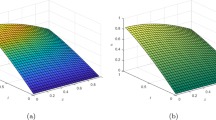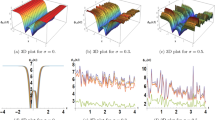Abstract
The solution of the integrable Hirota equation has attracted considerable attention in the applications of nonlinear optics, electromagnetics, and many other natural sciences. In this paper, we propose an improved physics-informed neural network (IPINN) method to study numerical solutions of the Hirota equation, which embeds energy conservation laws into a traditional neural network through the Lax pair formulation. Our simulation results show that the proposed method can predict the solutions and parameters of the Hirota equation more accurately than the traditional physics-informed neural network method. In addition, the influence on the rogue wave solution for the Hirota equation of the three factors of the IPINN method that are, number of network layers and hidden layer neurons, sampling points, and noises, is also analyzed in detail. In our study, it is worth noting that the presented method can achieve good prediction with fewer training data and iterations.










Similar content being viewed by others
Data availibility
Data will be made available on reasonable request.
References
Leta, T.D., Li, J.: Dynamical behavior and exact solution in invariant manifold for a septic derivative nonlinear Schrödinger equation. Nonlinear Dyn. 89(1), 509–529 (2017)
Lovász, B., Sándor, P., Kiss, G.Z., Bánhegyi, B., Rácz, P., Pápa, Z., Budai, J., Prietl, C., Krenn, J.R., Dombi, P.: Nonadiabatic nano-optical tunneling of photoelectrons in plasmonic near-fields. Nano Lett. 22(6), 2303–2308 (2022)
Cousins, W., Sapsis, T.P.: Unsteady evolution of localized unidirectional deep-water wave groups. Phys. Rev. E 91(6), 063204 (2015)
Akhmediev, N., Ankiewicz, A., Soto-Crespo, J.M.: Rogue waves and rational solutions of the nonlinear Schrödinger equation. Phys. Rev. E 80(2), 026601 (2009)
Hull, T.E., Infeld, L.: The factorization method, hydrogen intensities, and related problems. Phys. Rev. 74(8), 905 (1948)
Mio, K., Ogino, T., Minami, K., Takeda, S.: Modified nonlinear Schrödinger equation for Alfvén waves propagating along the magnetic field in cold plasmas. J. Phys. Soc. Jpn. 41(1), 265–271 (1976)
Kaup, D.J., Newell, A.C.: An exact solution for a derivative nonlinear Schrödinger equation. J. Math. Phys. 19(4), 798–801 (1978)
Xiang, X.S., Zuo, D.W.: Breather and rogue wave solutions of coupled derivative nonlinear Schrödinger equations. Nonlinear Dyn. 107, 1195–1204 (2022)
Jia, H.X., Zuo, D.W., Li, X.H., Xiang, X.S.: Breather, soliton and rogue wave of a two-component derivative nonlinear Schrödinger equation. Phys. Lett. A 405, 127426 (2021)
Zafar, A.J., Mitra, A., Apalkov, V.: Ultrafast valley polarization of graphene nanorings. Phys. Rev. B 106(15), 155147 (2022)
Shi, D., Li, M., Huang, G., Shu, R.: Polarization-dependent characteristics of a photon-counting laser ranging system. Opt. Commun. 456, 124597 (2020)
Ivanov, S.K., Kartashov, Y.V., Szameit, A., Torner, L., Konotop, V.V.: Floquet edge multicolor solitons. Laser Photonics Rev. 16(3), 2100398 (2022)
Sheveleva, A., Andral, U., Kibler, B., Colman, P., Dudley, J. M., Finot, C.: Ideal four wave mixing dynamics in a nonlinear Schrödinger equation fibre system (2022). arXiv:2203.06962
Hirota, R.: Exact envelope-soliton solutions of a nonlinear wave equation. J. Math. Phys. 14(7), 805–809 (1973)
Zhang, H.Q., Yuan, S.S.: Dark soliton solutions of the defocusing Hirota equation by the binary Darboux transformation. Nonlinear Dyn. 89(1), 531–538 (2017)
Zuo, D.W., Zhang, G.F.: Exact solutions of the nonlocal Hirota equations. Appl. Math. Lett. 93, 66–71 (2019)
Hao, H.Q., Zhang, J.W.: Studies on interactions between bound solitons in the Hirota equation. Superlattices Microstruct. 101, 507–511 (2017)
Nikolić, S.N., Aleksić, N.B., Ashour, O.A., Belić, M.R., Chin, S.A.: Systematic generation of higher-order solitons and breathers of the Hirota equation on different backgrounds. Nonlinear Dyn. 89(3), 1637–1649 (2017)
Djoptoussia, C., Tiofack, C.G.L., Mohamadou, A., Kofané, T.C.: Ultrashort self-similar periodic waves and similaritons in an inhomogeneous optical medium with an external source and modulated coefficients. Nonlinear Dyn. 107, 1–14 (2022)
Huang, Y., Di, J., Yao, Y.: The \(\overline{\partial }\)-dressing method applied to nonlinear defocusing Hirota equation with nonzero boundary conditions. Nonlinear Dyn. 111, 1–12 (2022)
Belyaeva, T.L., Serkin, V.N.: Nonlinear dynamics of nonautonomous solitons in external potentials expressed by time-varying power series: exactly solvable higher-order nonlinear and dispersive models. Nonlinear Dyn. 107(1), 1153–1162 (2022)
Yin, H.M., Pan, Q., Chow, K.W.: Doubly periodic solutions and breathers of the Hirota equation: recurrence, cascading mechanism and spectral analysis. Nonlinear Dyn. 110, 1–18 (2022)
Abdelrahim, M., Saiga, H., Maeda, N., Hossain, E., Ikeda, H., Bhandari, P.: Automated sizing of colorectal polyps using computer vision. Gut 71(1), 7–9 (2022)
Li, H.: Deep learning for natural language processing: advantages and challenges. Natl. Sci. Rev. 5(1), 24–26 (2018)
Tomov, M.S., Schulz, E., Gershman, S.J.: Multi-task reinforcement learning in humans. Nat. Hum. Behav. 5(6), 764–773 (2021)
Bar-Sinai, Y., Hoyer, S., Hickey, J., Brenner, M.P.: Learning data-driven discretizations for partial differential equations. Proc. Natl. Acad. Sci. 116(31), 15344–15349 (2019)
Panghal, S., Kumar, M.: Optimization free neural network approach for solving ordinary and partial differential equations. Eng. Comput. 37(4), 2989–3002 (2021)
Brink, A.R., Najera-Flores, D.A., Martinez, C.: The neural network collocation method for solving partial differential equations. Neural Comput. Appl. 33(11), 5591–5608 (2021)
Han, J., Jentzen, A., Weinan, E.: Solving high-dimensional partial differential equations using deep learning. Proc. Natl. Acad. Sci. USA 115(34), 8505–8510 (2018)
Georgoulis, E.H., Loulakis, M., Tsiourvas, A.: Discrete gradient flow approximations of high dimensional evolution partial differential equations via deep neural networks. Commun. Nonlinear Sci. 117, 106893 (2023)
Raissi, M., Perdikaris, P., Karniadakis, G.E.: Inferring solutions of differential equations using noisy multi-fidelity data. J. Comput. Phys. 335, 736–746 (2017)
Raissi, M., Perdikaris, P., Karniadakis, G.E.: Numerical Gaussian processes for time-dependent and nonlinear partial differential equations. SIAM J. Sci. Comput. 40(1), A172–A198 (2018)
Raissi, M., Perdikaris, P., Karniadakis, G.E.: Physics informed deep learning (part I): data-driven solutions of nonlinear partial differential equations (2017). arXiv:1711.10561
Raissi, M., Perdikaris, P., Karniadakis, G.E.: Physics informed deep learning (part II): data-driven discovery of nonlinear partial differential equations (2017). arXiv:1711.10566
Raissi, M., Perdikaris, P., Karniadakis, G.E.: Physics-informed neural networks: a deep learning framework for solving forward and inverse problems involving nonlinear partial differential equations. J. Comput. Phys. 378, 686–707 (2019)
Hornik, K., Stinchcombe, M., White, H.: Universal approximation of an unknown mapping and its derivatives using multilayer feedforward networks. Neural Netw. 3(5), 551–560 (1990)
Baydin, A.G., Pearlmutter, B.A., Radul, A.A., Siskind, J.M.: Automatic differentiation in machine learning: a survey. J. Mach. Learn. Res. 18, 1–43 (2018)
Arzani, A., Wang, J.X., D’Souza, R.M.: Uncovering near-wall blood flow from sparse data with physics-informed neural networks. Phys. Fluids 33(7), 071905 (2021)
Bai, Y., Chaolu, T., Bilige, S.: The application of improved physics-informed neural network (IPINN) method in finance. Nonlinear Dyn. 107(4), 3655–3667 (2022)
Kim, J., Lee, C.: Prediction of turbulent heat transfer using convolutional neural networks. J. Fluid Mech. 882, A18 (2020)
Fang, Y., Wu, G.Z., Kudryashov, N.A., Wang, Y.Y., Dai, C.Q.: Data-driven soliton solutions and model parameters of nonlinear wave models via the conservation-law constrained neural network method. Chaos Solitons Fractals 158, 112118 (2022)
Zhou, Z., Yan, Z.: Deep learning neural networks for the third-order nonlinear Schrödinger equation: bright solitons, breathers, and rogue waves. Commun. Theor. Phys. 73(10), 105006 (2021)
Bai, Y.: A novel method for solving third-order nonlinear Schrödinger equation by deep learning. Waves Random Complex 1–11 (2022)
Ankiewicz, A., Kedziora, D.J., Chowdury, A., Bandelow, U., Akhmediev, N.: Infinite hierarchy of nonlinear Schrödinger equations and their solutions. Phys. Rev. E 93(1), 012206 (2016)
Hisakado, M., Wadati, M.: Inhomogenious model for DNA dynamics. J. Phys. Soc. Jpn. 64(4), 1098–1103 (1995)
Kingma, D.P., Ba, J.: Adam: a method for stochastic optimization (2014). arXiv:1412.6980
Liu, D.C., Nocedal, J.: On the limited memory BFGS method for large scale optimization. Math. Program. 45(1), 503–528 (1989)
McKay, M.D., Beckman, R.J., Conover, W.J.: A comparison of three methods for selecting values of input variables in the analysis of output from a computer code. Technometrics 42(1), 55–61 (2000)
Ankiewicz, A., Soto-Crespo, J.M., Akhmediev, N.: Rogue waves and rational solutions of the Hirota equation. Phys. Rev. E 81(4), 046602 (2010)
Acknowledgements
The work was supported by the National Natural Science Foundation of China (Grant No. 11601411), the Natural Science Basic Research Plan in Shaanxi Province of China (Program No. 2021JM-448), and the Natural Science Basic Research Plan in Shaanxi Province of China (Program No. 2023-JC-YB-063).
Author information
Authors and Affiliations
Corresponding author
Ethics declarations
Conflict of interest
The authors declare that they have no conflict of interest concerning the publication of this manuscript.
Additional information
Publisher's Note
Springer Nature remains neutral with regard to jurisdictional claims in published maps and institutional affiliations.
Rights and permissions
Springer Nature or its licensor (e.g. a society or other partner) holds exclusive rights to this article under a publishing agreement with the author(s) or other rightsholder(s); author self-archiving of the accepted manuscript version of this article is solely governed by the terms of such publishing agreement and applicable law.
About this article
Cite this article
Zhang, R., Su, J. & Feng, J. Solution of the Hirota equation using a physics-informed neural network method with embedded conservation laws. Nonlinear Dyn 111, 13399–13414 (2023). https://doi.org/10.1007/s11071-023-08557-w
Received:
Accepted:
Published:
Issue Date:
DOI: https://doi.org/10.1007/s11071-023-08557-w




